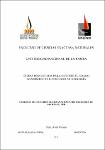Mostrar el registro sencillo del ítem
Geología de los diques del magmatismo Choiyoi, Bloque de San Rafael sur
| dc.contributor.advisor | Tickyj, Hugo | |
| dc.contributor.author | Stern, Ailén Micaela | |
| dc.date.accessioned | 2020-09-30T15:38:27Z | |
| dc.date.available | 2020-09-30T15:38:27Z | |
| dc.date.issued | 2017 | |
| dc.identifier.uri | https://repo.unlpam.edu.ar/handle/unlpam/2190 | |
| dc.description.abstract | En esta tesina se realizó un mapeo y una descripción litológica en cuerpos ígneos laminares (diques) del magmatismo Choiyoi emplazados en el sur de la Provincia Geológica Bloque de San Rafael, en el área comprendida entre las coordenadas geográficas 36º00'30' a 36º02'45' de latitud sur y 68º25'00' a 68º28'30' de longitud oeste. Los diques fueron agrupados en tres enjambres siguiendo criterios estructurales, litológicos y texturales. El primer enjambre de diques presenta una orientación N80ºE/subvertical, y está compuesto por fenolacitas sin cuarzo, de textura porfírica con pasta afanítica microcristalina y un porcentaje de fenocristales de 17,3%. El segundo enjambre tiene una orientación N70ºO/subvertical y está representado por fenoriolitas, de textura seriada con pasta microgranular felsítica y un porcentaje de fenocristales entre 50% y 57%. El tercer enjambre presenta una orientación N50-60ºO/subvertical, y se divide en dos subgrupos, uno de ellos conformado por rocas de una composición modal intermedia entre fenolacitas y fenotraquitas con un porcentaje de fenocristales de 22-35%, y otro compuesto por fenoriolitas con 35 a 44% de fenocristales. En ambos casos, la textura es seriada con pasta afanítica, microcristalina felsítica, exhibiendo además texturas de intercrecimiento entre cuarzo y feldespato. El último enjambre de diques presenta cuerpos laminares de hasta 40 m de espesor, los cuales muestran marcadas diferencias texturales entre el centro y sus bordes. Los bordes tienen texturas de intercrecimiento del tipo granofídico entre cuarzo y feldespatos, mientras que el centro del dique posee una textura microcristalina felsítica con fenocristales de mayor tamaño. Este cambio textural es atribuido a diferentes grados de sobreenfriamiento durante la cristalización del dique. En forma adicional, durante el análisis de las imágenes satelitales se identificó un cuerpo ígneo globoso de composición granítica, denominado Plutón Charito. Por su composición y morfología se infiere que su génesis podría estar relacionada con las fenoriolitas del tercer enjambre de diques. | |
| dc.description.abstract | In this thesis a mapping and a lithological description was made in tabular igneous bodies (dykes) of the Choiyoi magmatism located in the southernmost part of the San Rafael Block geological province, in an area situated between the geographical coordinates 36º00'30'' to 36º02'45'' south latitude and 68º25'00'' to 68º28'30'' west longitude. The dykes were grouped into three swarms following structural, lithological and textural criteria. The first swarm of dykes is orientated N80ºE/subvertical, and it is composed of phenolatites without quartz, with porphyritic texture, aphanitic microcrystalline groundmass and a total phenocryst content of 17.3%. The second swarm has a mean trend N70ºW/subvertical and is represented by phenorhyolites of serial texture, with a percentage of phenocrystals between 50% and 57%. Finally, the third swarm is orientated to N50-60ºW with near vertical dips and it is divided into two subgroups, one of them formed by rocks of an intermediate modal composition between phenolatite and phenotrachyte with a phenocryst percentage of 22-35%, and another composed of phenorhyolites with phenocryst content between 35 and 44%. In both cases, the texture is seriate with a felsitic, aphanitic microcrystalline groundmass, exhibiting intergrowth textures between quartz and feldspar. The last swarm of dykes presents thicker bodies up to 40 m, which show marked textural differences between the center and its edges. The edges have a granophyric texture in the groundmass, while the center has a felsitic microcrystalline texture with larger phenocrysts. These textural variations are attributed to different degrees of undercooling during the dyke crystallization. Additionally, during the analysis of the satellite images a globose igneous body of granitic composition, called Charito pluton, was identified. By its composition and morphology it is inferred that its genesis could be related to the phenorhyolites of the third swarm of dykes. | |
| dc.format.medium | application/pdf | |
| dc.language.iso | spa | |
| dc.rights | Atribución-NoComercial-CompartirIgual 2.5 Argentina (CC BY-NC-SA 2.5 AR) | |
| dc.rights.uri | https://creativecommons.org/licenses/by-nc-sa/2.5/ar/ | |
| dc.subject.other | Geología : : Petrología | |
| dc.title | Geología de los diques del magmatismo Choiyoi, Bloque de San Rafael sur | |
| dc.type | tesis | |
| dc.unlpam.subtype | tesina | |
| dc.unlpam.grado | Licenciado en Geología | |
| dc.unlpam.carrera | Licenciatura en Geología | |
| dc.unlpam.instituciondeorigen | Facultad de Ciencias Exactas y Naturales | |
| dc.unlpam.access | openAccess | |
| dc.unlpam.version | acceptedVersion | |
| dc.unlpam.filiacion | Stern, Ailén Micaela. Universidad Nacional de La Pampa; Argentina. | |
| dc.unlpam.filiacion | Tickyj, Hugo. Universidad Nacional de La Pampa; Argentina. |
Ficheros en el ítem
Este ítem aparece en la(s) siguiente(s) colección(ones)
-
Tesisg [1853]











